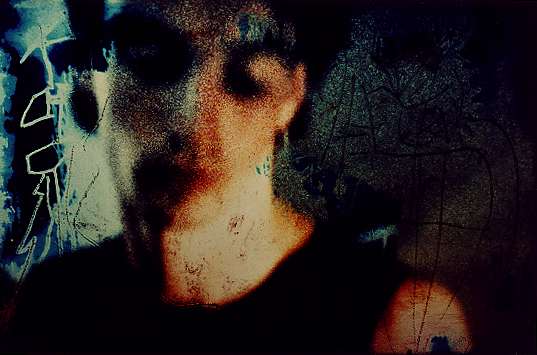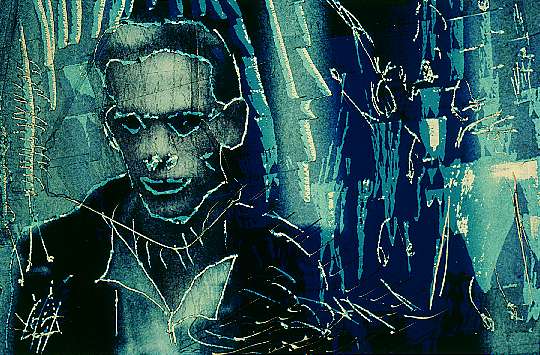The following text from Dr. Evers was written for the 1986 exhibition “Wandlungen einer Doppelnatur” (Transformations of a Dual Nature) in the Galerie Lichtblick (Ray of Hope Gallery) in Cologne. In 1987 Dr. Evers was the curator for an exhibition in Bonn in the “Die Wand” gallery (“The Wall”), which showed two of Lips’ works.
Dr. Ulrika Evers
Roger Lips - Wandlungen einer Doppelnatur (Transformations of a Dual Nature)
Above all in this exhibition, Roger Lips shows heads respectively pictures of people –snapshots from the street – that are further re-worked. At first glance, it seems Lips has provided them with a corresponding rather abstract picturesque painting.
Even though Roger Lips received his diploma as a designer at the Folkswangschule in Essen, he always tended more towards the photographic and then – equally important –the painting aspects. He left room for them in an abstract, almost informal “doodling,” which he used in his photos with the aid of certain techniques.
| Without title, 1985 |  |
The technical procedures, with which Roger Lips juggled, only play a role at first glance in order to awaken the initial interest: exaggerated enlargement, the scratching away of layers, the drawings that were added in to the photo, over- or underexposure, continuation of the negative’s development, the disintegration of structure, multiple underlayings of a motif in various colors. The technique is always the means to an end, never raises itself to a decorative existence on its own. But especially the technically re-worked photography often threatens to dangerously drift off in this direction.
Through the exaggerated enlargements of certain details of the pictures that were important to him, which make the coarse grain of the screen visible, comes a muddling, a blurring of the object, which forces the viewer to look more closely and then look once again, in order to determine what the picture is actually about. You see, Roger Lips gives the viewers some quite puzzling picture stories. Here’s an example: A somewhat hefty man (a boxer?), who – with his naked torso – looks rather like a brutal macho, is drawn so mellow through the blurring, that he seems almost vulnerable in his nakedness. The nudity and heftiness of the man combine in a peculiar ambivalence with one another: the man cannot really be clearly determined, is barely perceivable, so that his “dual nature” is illustrated.
| Without title (triptych), 1985 |  |
| Without title, 1985 |  |
The scratching away of the layers, say of a portrait, also makes it immediately clear what is meant: the look behind the mirror, the search for what is in the person, the real personality. Often enough the one portrayed in the photo sinks into a nothingness or – everything is possible – becomes a terrifying demon, a totem, a mask, an icon and Madonna, a grotesque face stiff and distorted with blood.
Those portrayed are always men, who have a certain erotic charisma of their very own, but it is always covered over by different emotions or existential expressions like absent-mindedness, pouting, grief. However an aura of sorrow envelopes every one. In some of the photos white has been sketched and/or scratched in, so that an intentional drawing-like level is created and the “reality” of the photos is broken up by cobwebs, snakes, doodled stick figures and abstract signs. The snake around the forehead of the construction worker needs no further explanation.
The drawing and the painting elements play an important role in Roger Lips’ work. He does not feel he is a photographer and truly – “in the classical sense” of his education and the way in which he has come closer step by step to this medium – he is not a photographer.
| Both without title, 1985 |  |
 |
In these photos, for which he refuses explanatory titles, Roger Lips shows
and questions different expressions of the human existence, but also how
one perceives a person, the instability of a moment in which one so very
quickly decides between sympathy or rejection, basically often only because
of a tiny detail. The special arrangement of two photos in this exhibition,
which deal with one another although they were not originally so intended,
emphasizes in addition the group constellations. The works examine how
people come to their relationships and show the as-well-as of a person,
their addition or neutralization. All things human have a “dual nature,”
no one is pinned down to only one thing, which can be an impression of
freedom or also of suffering, which one experiences from and through the
other.